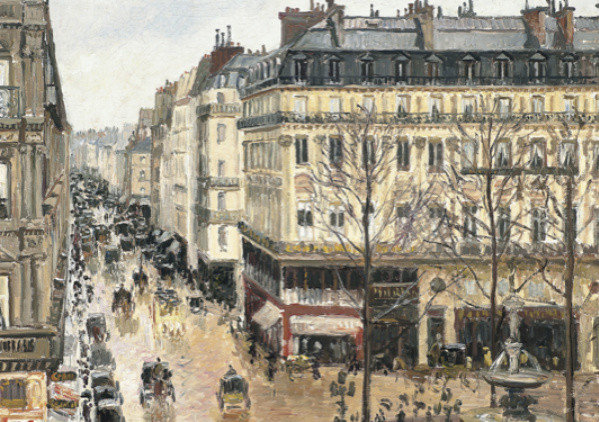I’ve just returned from my presentation in Heidelberg at the Hochschule für Jüdische Studien in Heidelberg at the conference Ersessene Kunst—Der Fall Gurlitt; Appropriated Art—The Gurlitt Case. The presentations were, without exception, outstanding. They ranged from rarely-told case stories, to sharp insights of some of the overarching principles that guide the the Gurlitt case and similar events. As the discussions made clear, this case will not be easily resolved. That in turn makes recent reports that Cornelius Gurlitt has indicated a willingess to discuss the art's return all the more significant.
Recap of Ersessene Kunst—Der Fall Gurlitt (Appropriated Art—The Gurlitt Case): January 26, 2014 in Heidelberg
Topics: Maria Altmann, Leopold Reidemester, Ministerin für Justiz und Kultur, Stuttgart, Das Alte Schauspielhaus, Cologne, Irina Alter, Portrait of Adele Bloch-Bauer, veschollene Kunst, Focus, Schwabinger Kunstfund, Aschbach Castle, Mussolini, Wiedergutmachung, Annette Weber, Monte Cassino, Cornelius Gurlitt, Corinna Budras, S. Lane Faison, Breslau, Universität Heidelberg, Augsburg, Aryanization, Anat Feinberg, Willi Korte, Schwabinger Kunstfund. Kunstfund München, Monuments Man, Jud Süss, Wrocław, Dresden, Gurlitt Task Force, Germany, Silesia, Fall Gurlitt, Wallraf-Richartz Museum, Köln, Nazi-looted art, Henry Keazor, Gurlitt Collection, Appropriated Art the Gurlitt Case, Schloss Aschbach, Die Welt, Kurpfälzische Museum Heidelberg, Hochschule für Judische Studien Heidelberg, Karl Haberstock, Eberhard Karls-Universität Tübingen, Emily Löffler, CSU, Williams College, Hildebrand Gurlit, Entartete Kunst, Universität Zürich, Arisierung, Lehrstuhl für Römisches Recht und Privatrecht, Württemberg, Schlesien, Nürnberger Institut, Hamburg, Otto Förster, Rückgabe, Beutekunst, 'Stürmer-Bibliothek', Magdeburg, Portrait of Amalie Zuckerkandl, Ersessene Kunst, Katja Terlau, Art Loss Recovery Unit, Jim Tobias, Hermitage, Gurlitt, Bavaria, Johannes Heil, Wien, Sullivan & Worcester LLP, Lucas Elmenhorst, Events, Kunsthistorisches Institut, Nürnberg, Jüdisches Museum Frankfurt, Looted Art, „Sturmer-Library“, degenerate art, Seminar für Neuere Geschichte, Wolfgang Ernst, Justizminister, Göring, www.lostart.de, Nazi art, Raubkunst, Nicholas M. O'Donnell, Frieder Hepp, Verjährung, Vienna, Claudius Krausharr, Münchner Kunstfund, Zwickau, Kajetan Mühlmann, New York, Werner Haftmann, FAZ Frankfurt, Felicitas Heiman-Jellinek
Secret Witness Contradicted Hildebrand Gurlitt’s Claim to Monuments Men that His Art was Burned in Dresden
From Dresden to Aschbach to Düsseldorf—New Scholarship in U.S. Archives Traces Hildebrand Gurlitt at War’s End, Could Affect Cornelius Gurlitt’s Claim to Good Faith Ownership
The Main Post has an article today (in German) by Christine Jeske tracing the late-war and post-war trajectory of Hildebrand Gurlitt and his now-infamous collection. The article is fascinating, and sheds considerable light on how the collection came through the war and how Gurlitt evaded greater scrutiny that might have revealed the trove’s whereabouts earlier. It also puts into context any claim Cornelius Gurlitt might now have to argue he took possession of the paintings from his father unaware of their provenance—what will be a critical argument, particularly if yesterday’s Cultural Property Restitution Law proposal by Bavaria becomes federal law in German.
Topics: Wiesbaden, Cultural Property Restitution Law, veschollene Kunst, Franken, Franconia, Hildebrand Gurlitt, Cornelius Gurlitt, George Clooney, Erik Berger, Augsburg, Dresden, Nuremberg, Fall Gurlitt, Monuments Men, Gurlitt Collection, Karl Haberstock, Kunstverein, Entartete Kunst, Munich, Heiner Dikreiter, Beutekunst, Freiherr Gerhard von Pölnitz, Bavaria, Kulturgut-Rückgewähr-Gesetz, Nürnberg, Düsseldorf, Schlüsselfeld, Monuments Fine Arts and Archives, Gemäldegalerie Dresden, Christine Jeske, Walter Paech, degenerate art, Städtische Galerie, München, Main Post, Karl and Magdalene Haberstock Foundation, Raubkunst, Verjährung, Nazi Raubkunst, Aschbach
Bavaria Proposes Cultural Property Restitution Act, Heads to Berlin for Federal Approval
As reported yesterday, the government of Bavaria has moved ahead with a proposal to amend the statute of limitations over art claims like those arising out of the Gurlitt find in Schwabing/Munich. The “Draft law for the exclusion of limitations on claims for misappropriated cultural property, particularly from the Nazi era (Cultural Property Restitution Law)” would bar the assertion of a statute of limitations where the current possessor does not hold the property in good faith. The draft is now publicly available, here (albeit in German). The proposal is not limited to Bavaria, rather, it is for consideration by Germany’s federal; parliament in Berlin (first the upper chamber, or Bundesrat, followed by the Bundestag).
Topics: Berlin, Ministerin für Justiz und Kultur, Cultural Property Restitution Law, veschollene Kunst, Schwabinger Kunstfund, Cornelius Gurlitt, Gurlitt Task Force, Fall Gurlitt, Gurlitt Collection, Kulturgut, Entartete Kunst, Declaration of the Federal Government the Länder a, Munich, Beutekunst, Schwabing, Bundestag, Bundesrat, Bavaria, Kulturgut-Rückgewähr-Gesetz, degenerate art, Freistaat Bayern, Justizminister, München, Raubkunst, Verjährung, Winfried Bausback
Bavaria to Review Draft Revision to Statute of Limitations on Claims to Art Found in Gurlitt Apartment
Die Welt reports today that a scheduled cabinet meeting of the government of Bavaria includes discussion of a draft revision to the state’s statute of limitations. Justice Minister Winfried Bausback (CSU) has apparently stated his desire to ensure that claimants like those heirs to owners of works found in Cornelius Gurlitt’s apartment will not be barred by the statute of limitations, following through on statements he made last year after being selected. There has been lively discussion of whether such claims would be time barred, but this revision would presumably be intended to answer the question broadly. It could signal the beginning of legislative steps to address the situation. The previous Justice and Culture Minister Beate Merk had come under heavy criticism, but a new minister may have room to make some changes. And, in a parliamentary system, the consensus of the ruling government is more significant in anticipating the passage of legislation.
Topics: Ministerin für Justiz und Kultur, Legal Tribune, veschollene Kunst, Beate Merk, Cornelius Gurlitt, Augsburg, Schwabinger Kunstfund. Kunstfund München, Gurlitt Task Force, Germany, Fall Gurlitt, Gurlitt Collection, Die Welt, Lorenz Kähler, CSU, Hildebrand Gurlit, Entartete Kunst, Ingeborg Berggreen-Merkel, Beutekunst, Magdeburg, Gurlitt, Bavaria, degenerate art, Freistaat Bayern, Justizminister, www.lostart.de, Nazi art, Raubkunst, Verjährung, Winfried Bausback
Cassirer Heirs' Claims to Pissarro Work Revived by Appeals Court, the Year 2013 Shows that the Tide for Restitution May be Shifting Again
The U.S. Court of Appeals for the 9th Circuit restored last week claims by heirs of Lilly Cassirer against the Thyssen-Bornemisza Collection for the return of the Camille Pissarro painting Rue St. Honoré, après-midi, êffet de pluie.
Topics: Nuremberg laws, Schwabinger Kunstfund, Cornelius Gurlitt, Lilly Cassirer, California Code of Civil Procedure § 338(c), Dorothy Nelson, Thyssen-Bornemisza Collection, Julius Schoeps, Rue St. Honoré après-midi êffet de pluie, Claude Cassirer, Von Saher v. Norton Simon, de Csepel, Jacques Goudstikker, California Code of Civil Procedure § 354.3, Gurlitt Collection, Foreign Sovereign Immunities Act, Hans Sachs, Von Saher v. Norton Simon Museum of Art at Pasaden, Madame Soler, Bundesgerichtshof, Hildebrand Gurlit, Entartete Kunst, Hans-Heinrich Thyssen-Bornemisza, Hungarian National Gallery, Nazis, Munich, Deutches Historisches Museum, FSIA, Preemption, Gurlitt, Harry Pregerson, Restitution, field preemption, Marei Von Saher, Herzog collection, Bavaria, Claudia Seger-Thomschitz, Looted Art, World War II, Foreign Sovereign Immunities, Pinakothek der Moderne, degenerate art, Altmann v. Republic of Austria, 578 F.3d 1016, Freistaat Bayern, beschlagnahmte Kunst, Camille Pissarro, Kim McLane Wardlaw, Nürnberger Gesetze, Raubkunst, Museum of Fine Arts Boston, Cassirer v. Thyssen-Bornemisza Collection, verschollene Kunst, Kunstfund München
327 Gurlitt Collection Works Now Known; Time for Claims in the United States?
The coordination office in Magdeburg continues to post details about works of art seized from Cornelius Gurlitt in Schwabing, with a total of 327 works now available for viewing. There has been almost no discussion yet, however, of what process the government will employ to allow claimants to make their case. Those in the United States have options discussed further below.
Topics: veschollene Kunst, Schwabinger Kunstfund Cornelius Gurlitt, Strafprozessordnung, Hildebrand Gurlitt, EBS Dispute Resolution Center, Munich Hoard, IFKUR, Verjährungsfrist, Peter Bert, Germany, Matthias Weller, prescriptive ownership, Nazi-looted art, Gurlitt Collection, Foreign Sovereign Immunities Act, Baden-Württemberg, Entartete Kunst, Nazis, Ingeborg Berggreen-Merkel, Munich, Schwabing, Magdeburg, FSIA, Dispute Resolution in Germany, Bavaria, Looted Art, Foreign Sovereign Immunities, deutches Recht, degenerate art, Altmann v. Republic of Austria, www.lostart.de, stop, Raubkunst, German Civil Code § 221, Sec. 108 German Code of Criminal Procedure, Kunstfund München, Münchner Kunstfund




